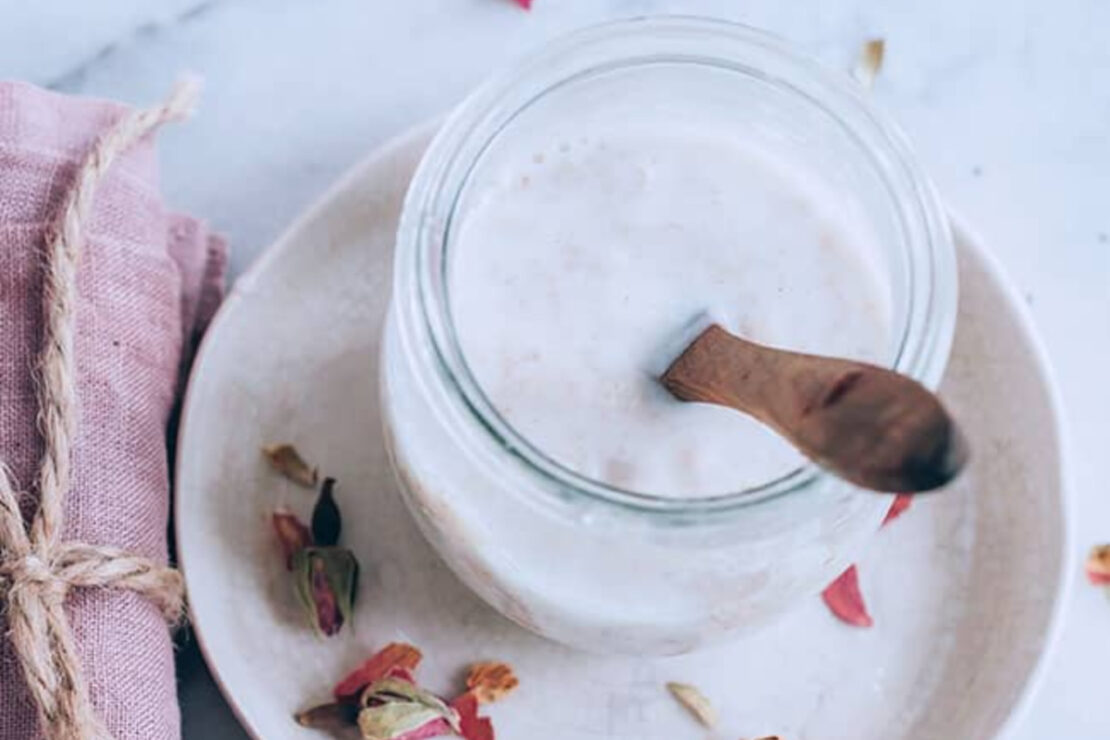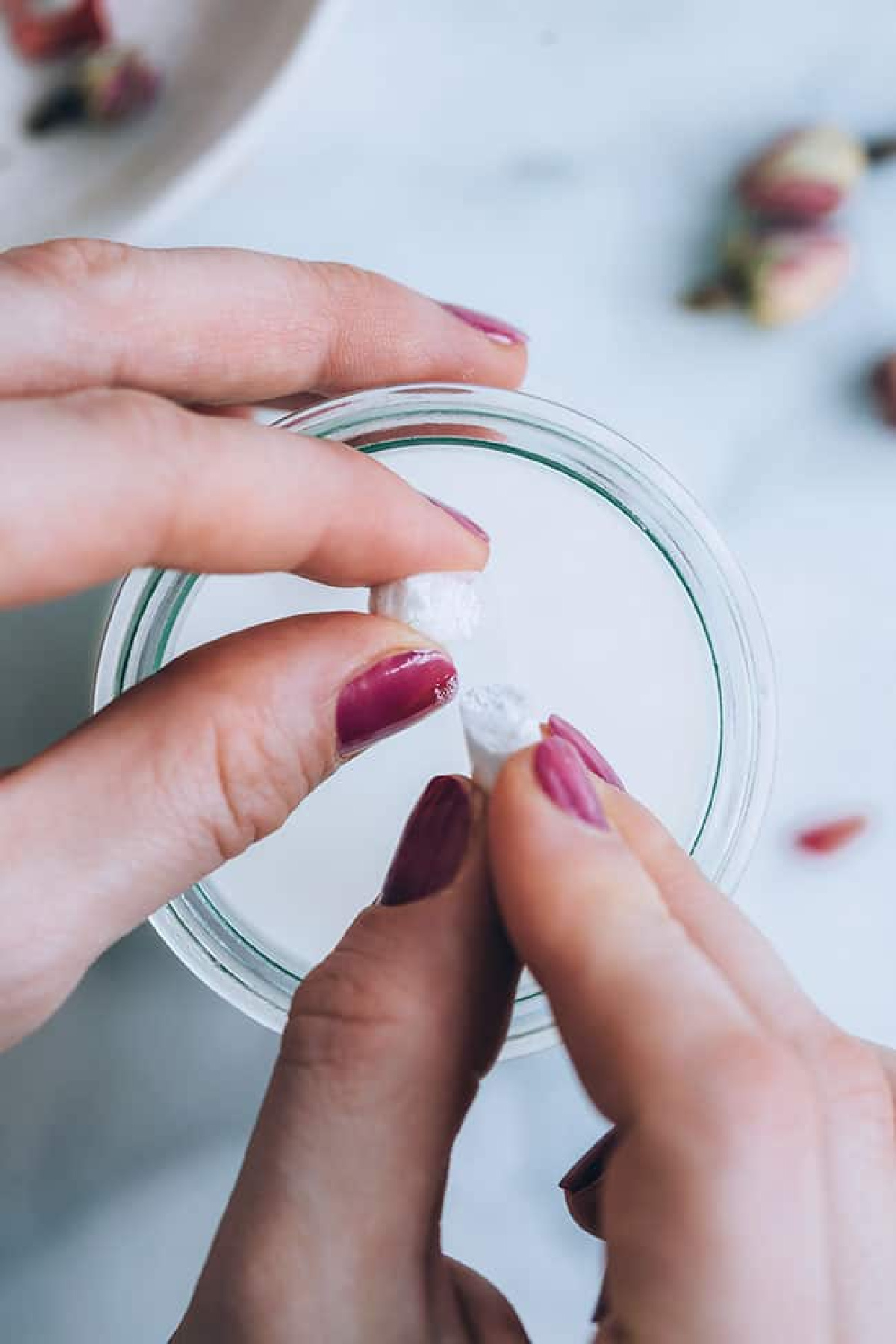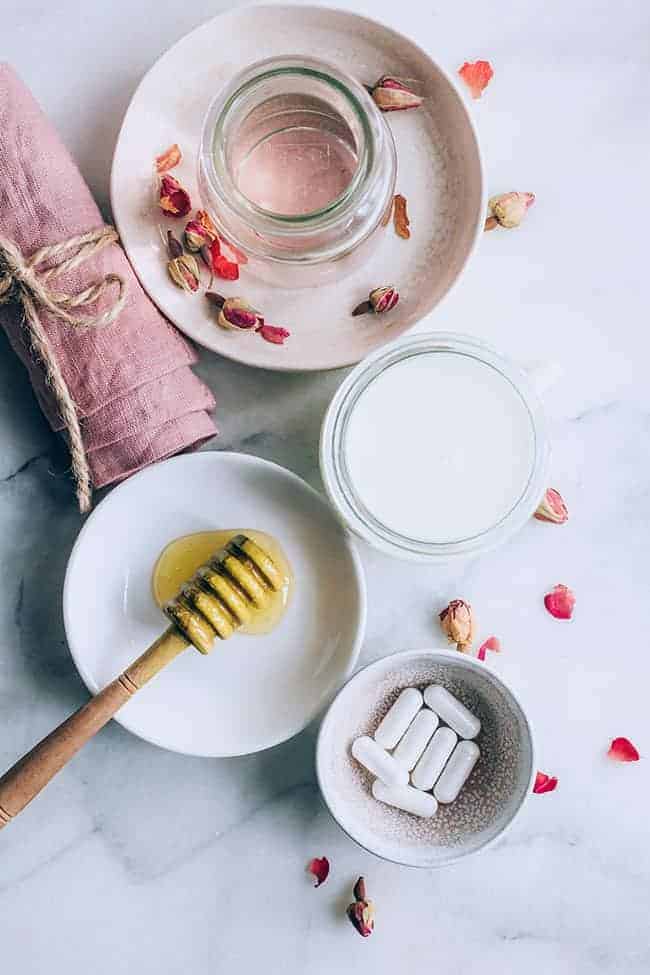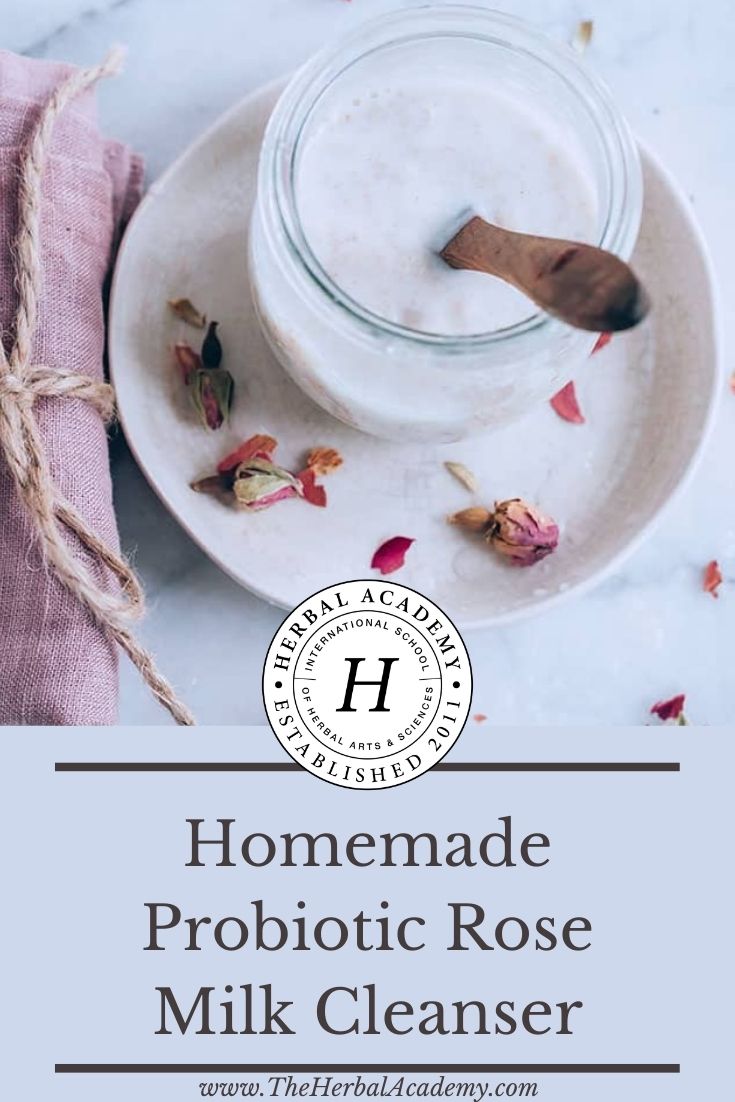
Homemade Probiotic Rose Milk Cleanser
When I was writing and creating natural DIY beauty recipes for Hello Gorgeous: 100 Fabulous DIY Facials You Can Do at Home, I focused on the simple idea that most skincare problems can be resolved the natural way: by putting nourishing food on your face. If it’s good enough to eat, it’s good enough to put on your face, right? This rose milk cleanser does just that.
I love to raid my pantry, get messy, and create my own skincare products—because creating your own recipes at home is not only a fun, cost-saving activity, but it’s also empowering! This recipe for homemade probiotic rose milk cleanser is no exception.
By now many of us are familiar with the role that good bacteria and friendly floral play in our gut health, but did you know that you can put probiotics to work in your facial routine as well? When applied topically, probiotics can help balance your skin, fight harmful free radicals, and reduce inflammation.
This simple DIY rose milk cleanser, which contains rosewater, organic coconut milk, probiotic capsules, and raw honey, is a great way to start introducing live bacteria into your skincare routine. In addition to the probiotic capsules used in this recipe, raw honey also contains probiotics, so adding it to the mix helps boost the amount of good bacteria in this cleanser even more.
While this recipe is great for acne-prone skin, it’s also soothing and gentle enough for sensitive skin. Aside from its lovely smell, the rosewater in this recipe serves as an anti-inflammatory, which is typically my first line of defense for treating puffy eyes and painful breakouts.
Rosewater plays a key part in this recipe because rose petals are rich in phenols, flavonoids, and other antioxidant compounds (Nowak, 2014) and have been found to have many benefits, including anti-wrinkle effects (Song, 2020).
But as you may know, rosewater can cost a pretty penny at your favorite beauty retailer, which is why I’ve started making my own with petals from organic or homegrown roses. I’ve always loved using rosewater as a toner in my beauty routine because of its astringent properties, so I was thrilled to discover how easy it is to make your own rosewater at home. Aside from saving a few bucks, making your own allows you to control what goes into the mix (and to avoid additives like fragrance and dyes, which can be found in some store-bought rosewater).

Probiotic Cleanser Pro Tips
To make this probiotic rose milk cleanser, pour the coconut milk and rosewater in a glass jar and add the probiotics and honey. Cover and store in the refrigerator to keep the bacteria active. One word of advice: be sure to use the cream of the coconut milk only in this recipe (not the watery liquid in the can). If you’d like, you can substitute coconut milk for coconut oil.
Be sure to cover and store your probiotic cleanser in the refrigerator between uses to keep the bacteria alive. To soften up this cleanser before use, I like to warm the jar in the palms of my hands before applying the product to my face. I start by applying 1-2 teaspoons to my face and neck, massaging it in for at least a minute with slow, gentle circles before rinsing with warm water.
I love the ritual of this cleansing process! The scent of the rosewater is divine, and the act of massaging the cleanser into your skin can serve as a much-needed reminder to slow down and fully focus on the sensations in the present moment. For best results, I recommend using this rose cleanser 2-3 times per week.
If you’re wondering what kind of probiotics to use, this recipe calls for the same kinds of probiotics you would normally ingest. Feel free to use your favorite brand or what you already have on hand in your medicine cabinet.
There are, however, a few tips on choosing and storing a high quality probiotic to keep in mind:
- Any probiotic you choose should contain live, active bacteria.
- Most probiotics need to be stored in the refrigerator, so read the label carefully.
- Probiotics are measured in colony-forming units (CFUs). Most range from 1-10 billion CFUs.
- The National Institutes of Health Office of Dietary Supplements notes in its probiotics fact sheet that higher CFU counts do not necessarily improve a product’s health effects (National Institutes of Health Office of Dietary Supplements, 2020). However, the agency advises that you look for products labeled with the number of CFUs at the end of the product’s shelf life—not at the time it was manufactured—because probiotics must be consumed alive to have health benefits (and the microorganisms can die during their shelf life).
- Take note of the expiration date before use or consumption to ensure the best results. (I keep a permanent marker handy to write the expiration date in big bold numbers on the bottle to help me determine at a glance if it has expired.)
This recipe originally appeared in Hello Gorgeous: 100 Fabulous DIY Facials You Can Do at Home by Stephanie Gerber. Hello Gorgeous is the ultimate guide to putting your best face forward with simple, all-natural face masks, mists, toners, and treatments that you can make with ingredients you already have in your pantry, kitchen, and garden.

Homemade Probiotic Rose Milk Cleanser
This simple DIY rose milk cleanser, which contains rosewater, organic coconut milk, probiotic capsules, and raw honey, is a great way to start introducing live bacteria into your skincare routine.
1 tablespoon organic coconut milk from can (coconut oil can be substituted)
1 teaspoon rosewater
2 capsules live probiotics
1 tablespoon raw honey
Glass jar with lid
Spoon
- Scoop out the cream of the coconut milk (do not use any watery liquid).
- Pour coconut milk into a glass jar and add rosewater.
- Add in live probiotics by pulling capsules apart and pouring contents into the jar.
- Add raw honey and stir thoroughly.
- Apply 1-2 teaspoons to the face and neck. Massage into skin for at least a minute in slow, gentle circles.
- Rinse with warm water.
- Cover and store in the refrigerator to keep bacteria active.
- To soften the product prior to use, warm the jar in the palms of your hands. For best results, use 2-3 times per week.
In Closing,
Once you start creating your own all-natural beauty products at home, I think you’ll find that the process is so fun and rewarding! It’s such a great way to customize products to meet your specific needs and to control the ingredients that go into the mix. If you’re looking for more homemade skincare recipes, we’ve got a lot of tips and ideas to help you create a natural skincare routine with DIY creams, moisturizers, and masks, all of which are natural and actually good for you!

REFERENCES
National Institutes of Health Office of Dietary Supplements. (2020). Probiotics: fact sheet for health professionals [Online Article]. Retrieved from https://ods.od.nih.gov/factsheets/Probiotics-HealthProfessional/
Nowak, R., Olech, M., Pecio, L., Oleszek, W., Malm, A., & Rzymowska, J. (2014). Cytotoxic, antioxidant, antimicrobial properties and chemical composition of rose petals [Abstract]. Journal of the Science of Food and Agriculture, 94(3), 560-567.
Song, Y.R., Lim, W.C., Han, A., Lee, M.H., Shin, E.J., Lee, K.M., … Lim, T.G. (2020). Rose petal extract (Rosa gallica) exerts skin whitening and anti-skin wrinkle effects [Abstract]. Journal of Medicinal Food, 23(8), 870-878.







